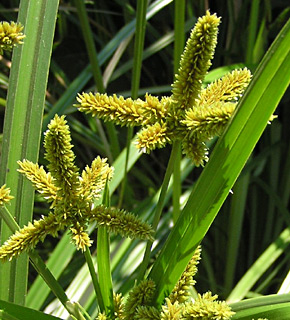Cyperus alopecuroides is a very tall and erect perennial herbaceous plant, and is one of the most beautiful Cyperus (Reed) species in Israel. Cyperus alopecuroides blooms in the summer, from June to October, like many of the water plants that are not forced to withstand a problem of water scarcity during the warm season. The inflorescence is beautiful. It is composed of 3-8 unequal arms that extend from a single point, and are up to 18 cm long. Elongated, thick (up to 10 mm) and dense spikes are arranged on the longitudinal axis of each arm. The flowers are arranged inside the spikes in ovate spikelets that are 2-3 mm wide, and with a length that is double their width. The glumes are ovate or lanceolate, dense, imbricate, with a flat back. Their margins are folded inwards, and they become divaricate after the bloom ends. They are brown or straw-colored. The inflorescence is covered at its base by leaves that are longer than the inflorescence and reach a length of up to 30 cm. Cyperus alopecuroides grows in marshes and on shorelines. It is common mainly in the Beit-Zida Valley and the Hula Valley, a little in the Jezreel Valley and in the Coastal Plain. Its global distribution spreads over tropical regions in the Old World.
Cyperus (Reeds) is a huge genus, which includes 300 plant species (some claim 600 or even 700), which are common in all continents, in tropical and subtropical regions. The leaves extend from the base of the plant, their blades are linear, and the sheath is a closed tube. The plant has a stem (which is not considered to be a culm, because it is not hollow, and this differentiates the Cyperaceae from the Gramineae, which are similar but their stem is hollow), and the head of the stem carries a single inflorescence in the shape of an umbel or capitulum. The stem is not divided into nodes, it is leafless, and it is usually ribbed, with 3 sides. The inflorescence is enveloped by leaf-like bracts and has several spikes, where each is composed of compressed spikelets, and each spikelet contains numerous flowers. The spikelet lemmas are arranged in two imbricate opposite rows. The flower is small, and lacks a perianth. It is not colorful. Each flower has 3 long weak stamens (sometimes 1 or 2) as usual in flowers that are pollinated by wind. It has a style with 2 or 3 stigmata, usually curled. The fruit is a single-seed nutlet. Most Reed species are found in humid habitats, and are herbaceous water plants with thickened rhizomes or bulbs. The rhizome serves the plant for vegetative reproduction. In some species the rhizome or bulb is used by humans as a source for edible carbohydrates or for medicinal substances. Other species are cultivated in gardens as ornamental plants. The most familiar Reed species are Cyperus papyrus (Nile papyrus, Paper Reed), which was used by the ancients to make paper, and Cyperus rotundus (Nutgrass), which is sometimes considered the most harmful weed in the world. Twenty two different species of Reed grow in Israel, many of which are rare and on the verge of extinction, because the habitats of fresh water are endangered around the entire globe, and especially in Israel, due to drying and draining, depletion of water sources, overuse and pollution.
The Cyperaceae family includes 3,000 species in 85 genera. In Israel there are representatives of 8 genera.
Written by Mike Livne




